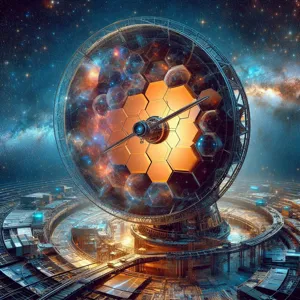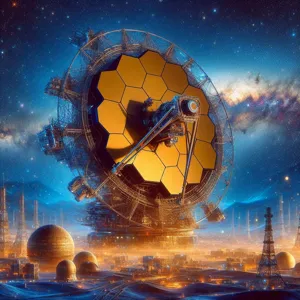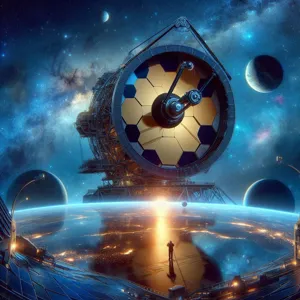The universe is a vast and awe-inspiring expanse, filled with mysteries waiting to be unraveled.
As we gaze up at the night sky, we are often captivated by the twinkling stars, distant galaxies, and the intricate dance of celestial bodies. But what lies behind the breathtaking beauty of the cosmos? This is where the fields of astronomy and astrophysics come into play. While astronomy allows us to observe and catalog the celestial phenomena that fill our nights, astrophysics dives deeper, exploring the underlying principles and laws that govern the universe’s behavior. In this blog post, we will embark on a fascinating journey to uncover the intricate relationship between these two disciplines, examining how they complement and enhance one another in our quest to understand the cosmos. From the birth of stars to the mysteries of black holes, join us as we explore the interconnected threads that weave together our understanding of the universe and our place within it.
1. Introduction to Astronomy and Astrophysics

The vastness of the universe has captivated human imagination for centuries, giving rise to two intertwined disciplines that seek to unravel its secrets: astronomy and astrophysics. At their core, astronomy is the scientific study of celestial objects, space, and the physical universe as a whole. It encompasses everything from the observation of planets, stars, and galaxies to the mapping of cosmic events like supernovae and black holes. Historically, it began as a blend of mythology and observation, with ancient civilizations gazing at the night sky, charting constellations, and attributing stories to the celestial bodies above.
Astrophysics, on the other hand, delves deeper into the principles that govern these celestial phenomena. It applies the fundamental laws of physics and chemistry to understand the nature of the universe. Astrophysicists analyze the properties of celestial bodies, such as their temperature, mass, luminosity, and composition, seeking to answer profound questions about their formation, evolution, and ultimate fate. This branch of science combines theoretical frameworks with observational data, allowing researchers to test hypotheses and refine our understanding of the cosmos.
Together, astronomy and astrophysics form a comprehensive approach to studying the universe. While astronomy provides the observational backbone—through telescopes, satellites, and space missions—astrophysics offers the theoretical insights that explain the data collected. This collaboration has led to significant breakthroughs, from the discovery of exoplanets and the evidence of gravitational waves to the realization of the expanding universe and the enigmatic dark matter that constitutes most of its mass.
As we embark on this journey to explore the cosmos, we will delve into the key principles, methodologies, and discoveries that define these disciplines. By understanding how astronomy and astrophysics work hand in hand, we can appreciate not only the beauty of the night sky but also the intricate mechanics that govern its vast and mysterious expanse.
2. Historical Background: The Evolution of Astronomy
The story of astronomy is as vast and intricate as the cosmos it seeks to understand. From the earliest civilizations gazing up at the night sky, the evolution of this science has been marked by remarkable discoveries and profound shifts in perspective. Ancient cultures, such as the Babylonians and the Egyptians, were among the first to meticulously observe celestial bodies, developing rudimentary calendars and predicting celestial events like eclipses. Their observations were not merely scientific; they were interwoven with mythology and religion, as the movements of stars and planets were often seen as manifestations of divine will.
As we move through history, we encounter pivotal figures who propelled astronomy forward. In the 2nd century, Claudius Ptolemy presented the geocentric model, positioning Earth at the center of the universe—a view that dominated for over a millennium. However, the Renaissance heralded a seismic shift. With the advent of the telescope, astronomers like Nicolaus Copernicus, Galileo Galilei, and Johannes Kepler began to challenge long-held beliefs. Copernicus’s heliocentric model reshaped our understanding of the solar system, while Galileo’s observations of Jupiter’s moons provided empirical evidence that not everything revolved around Earth.
The 17th century also saw the rise of Isaac Newton, whose laws of motion and universal gravitation provided a theoretical framework that explained celestial mechanics. This laid the groundwork for subsequent developments in both astronomy and physics. As we entered the 20th century, the field took another leap forward with the introduction of spectroscopy and the realization that the universe is expanding, thanks to Edwin Hubble’s groundbreaking observations.
Today, astronomy stands at the intersection of art and science, blending meticulous observation with cutting-edge technology. Telescopes that capture light from distant galaxies and space probes that traverse the solar system have expanded our horizons far beyond what early astronomers could have imagined. The journey from ancient star-gazers to modern astrophysics is a testament to human curiosity and innovation, revealing not only the workings of the universe but also our place within it. As we continue to explore the cosmos, the historical evolution of astronomy reminds us of the profound connections between observation, understanding, and the quest for knowledge.
3. Key Concepts in Astronomy

When delving into the cosmos, understanding key concepts in astronomy is essential for both enthusiasts and scholars alike. Astronomy, the study of celestial bodies and the universe as a whole, is rich with foundational ideas that illuminate our understanding of the night sky.
At the heart of astronomy lies the concept of celestial mechanics, which governs the motions of planets, moons, and stars. This intricate dance of gravitational forces allows us to predict the positions of celestial objects and comprehend the vast distances that separate them. Familiar terms like orbits, eccentricity, and Kepler’s laws are vital in this realm, providing a framework for understanding how bodies in space interact.
Another crucial aspect is the classification of celestial objects. From the dazzling array of stars, which can be classified by their size, temperature, and brightness, to the diverse categories of galaxies—spiral, elliptical, and irregular—each type offers insights into the evolution of the universe. The life cycle of stars, from their birth in nebulae to their explosive deaths as supernovae, paints a vivid picture of the dynamic processes at play in space.
Additionally, the electromagnetic spectrum plays a pivotal role in astronomy. Understanding how light and other forms of radiation travel through space allows astronomers to gather information about distant objects. Telescopes equipped to detect various wavelengths—from radio waves to gamma rays—enable researchers to study celestial phenomena across the spectrum, revealing secrets about the universe that are otherwise hidden.
Lastly, the concept of redshift offers a glimpse into the universe’s expansion. As galaxies move away from us, their light stretches into longer wavelengths, indicating that the universe is not static but ever-growing. This realization has profound implications, not only for our understanding of the cosmos but also for the very nature of time and space.
Together, these key concepts form the backbone of astronomy, guiding researchers as they explore the mysteries of the universe. Whether you’re gazing up at the stars with wonder or diving deep into the science behind them, these foundational ideas are essential for appreciating the vast and intricate cosmos that surrounds us.
4. Fundamental Principles of Astrophysics
Astrophysics, a branch of science that intertwines the fascinating realms of physics and astronomy, seeks to unravel the mysteries of the universe by applying the laws of physics to celestial phenomena. At the heart of this discipline lie several fundamental principles that serve as the foundation for understanding the complex behaviors and interactions of astronomical objects.
One of the core principles of astrophysics is gravitational theory, which describes how massive objects exert a force on one another, shaping the structure and dynamics of the universe. This principle is crucial for explaining the orbits of planets around stars, the formation of galaxies, and the behavior of cosmic entities such as black holes. Newton’s law of universal gravitation laid the groundwork for this understanding, later expanded by Einstein’s general relativity, which introduced the concept of spacetime curvature. This advancement allows astrophysicists to explore phenomena such as gravitational waves, the bending of light around massive objects, and the expansion of the universe itself.
Another fundamental principle is thermodynamics, particularly the laws governing energy transfer and heat within celestial bodies. Astrophysicists study how stars generate energy through nuclear fusion, converting hydrogen into helium at their cores and emitting light and heat into space. This understanding not only informs us about the lifecycle of stars—from their birth in nebulae to their eventual demise as supernovae or white dwarfs—but also impacts our comprehension of planetary atmospheres and their capacity to support life.
The principles of electromagnetism also play a pivotal role in astrophysics. The interaction of charged particles with magnetic fields leads to phenomena such as solar flares, auroras, and cosmic rays. By studying the electromagnetic spectrum—from radio waves to gamma rays—astrophysicists can glean valuable insights about the composition, temperature, and motion of celestial bodies. This spectral analysis allows for the identification of elements within stars and galaxies, guiding our understanding of the universe’s chemical evolution.
Lastly, the principle of relativity challenges our perceptions of time and space, particularly in extreme gravitational fields. Astrophysicists leverage these principles to explore high-energy environments, such as those found near black holes and neutron stars. Understanding how time dilates and space contracts in these scenarios is crucial for advancing our knowledge of the universe’s deepest secrets.
In summary, the fundamental principles of astrophysics create a rich tapestry that connects the dots between physics and astronomy. By applying these foundational concepts, astrophysicists continue to push the boundaries of our knowledge, exploring the cosmos and unveiling the intricate processes that govern the universe. The interplay of these principles not only enhances our understanding of celestial phenomena but also fuels our innate curiosity to explore the vastness of space.
5. The Role of Telescopes in Astronomy

Telescopes have long been the eye through which we explore the cosmos, revolutionizing our understanding of the universe and our place within it. These magnificent instruments serve as gateways to the distant realms of space, allowing astronomers to observe celestial bodies and phenomena that are otherwise invisible to the naked eye. The role of telescopes in astronomy is not merely about magnification; it is about unlocking the secrets of the universe, one observation at a time.
There are various types of telescopes, each designed to capture different aspects of the cosmos. Optical telescopes, which use lenses or mirrors to gather and focus light, have been instrumental in charting the night sky. From Galileo’s rudimentary telescope that first revealed the moons of Jupiter to the powerful Hubble Space Telescope, which has provided breathtaking images of distant galaxies, optical telescopes have paved the way for countless discoveries.
However, astronomy extends beyond the visible spectrum. Radio telescopes, for instance, collect data from radio waves emitted by celestial objects, unveiling phenomena such as pulsars, quasars, and cosmic microwave background radiation. These instruments have allowed astronomers to probe the universe in ways that optical telescopes cannot, offering insights into the structure and evolution of galaxies, as well as the mysteries of dark matter and dark energy.
Then there are space-based telescopes, like the James Webb Space Telescope, which have taken the exploration of the cosmos to new heights—literally. Operating beyond the distorting effects of Earth’s atmosphere, these telescopes provide unparalleled clarity and depth, capturing light from the earliest stars and galaxies formed after the Big Bang. The data collected by these advanced instruments not only enhances our understanding of cosmic history but also helps astrophysicists develop models that explain the fundamental laws of physics.
In essence, telescopes are more than just tools; they are instruments of discovery that have transformed our understanding of the universe. By utilizing a blend of optical, radio, and space-based technologies, astronomers can piece together the vast tapestry of the cosmos, revealing a world that is both awe-inspiring and complex. As technology continues to advance, the role of telescopes in astronomy will only grow more critical, illuminating the dark corners of the universe and inspiring future generations to look up, wonder, and explore.
6. The Interplay Between Astronomy and Astrophysics
The interplay between astronomy and astrophysics is a fascinating dance that has captivated scientists and enthusiasts alike for centuries. At first glance, astronomy may seem to concern itself solely with the observation and cataloging of celestial bodies—planets, stars, galaxies, and nebulae—while astrophysics delves into the underlying principles and laws that govern the universe’s behavior. However, these two fields are inextricably linked, each relying on the other to deepen our understanding of the cosmos.
Astronomy provides the observational data that astrophysicists use to develop theories about the physical and chemical processes occurring in space. For example, astronomers might detect the faint light from a distant galaxy, prompting astrophysicists to apply their mathematical models to interpret the galaxy’s composition, age, and even the dynamics of its formation. In this way, observations serve as the foundation for theoretical exploration, revealing the intricate details of celestial phenomena.
Conversely, astrophysics offers the frameworks and models that help astronomers refine their observations and enhance their techniques. By understanding the principles of gravity, radiation, and thermodynamics, astronomers can develop more sophisticated instruments, from powerful telescopes that peer into the depths of space to advanced algorithms that sift through vast datasets. This symbiotic relationship fosters innovation, leading to groundbreaking discoveries that push the boundaries of human knowledge.
One striking example of this interplay is the study of supernovae. Astronomers observe these explosive events, which mark the deaths of massive stars, while astrophysicists unravel the complexities behind their mechanics, exploring how they contribute to the cosmic cycle of matter. This collaboration has not only advanced our understanding of stellar evolution but has also shed light on the expansion of the universe itself.
As we explore the cosmos, it becomes increasingly clear that astronomy and astrophysics are two sides of the same coin, each enriching the other to create a more comprehensive narrative of our universe. This intricate relationship not only enhances scientific inquiry but also fuels our collective curiosity about the mysteries that lie beyond our planet. By embracing both fields, we embark on a journey that not only seeks to answer profound questions about existence but also inspires future generations to look up at the stars and wonder.
7. Observational Techniques: From Ground-Based to Space Telescopes

The field of astronomy has always been a testament to humanity’s unyielding curiosity about the universe, and at the heart of this exploration lies the critical component of observational techniques. From the rugged terrains of Earth to the vast expanse of space, astronomers have developed a range of tools and methodologies to unveil the mysteries of the cosmos.
Ground-based telescopes have been the backbone of astronomical observation for centuries. Nestled atop mountains or in remote areas, these telescopes benefit from the clearer skies and reduced atmospheric interference found in elevated locations. Equipped with advanced optics and imaging technology, they allow astronomers to observe celestial phenomena such as distant galaxies, nebulae, and stellar formations. However, the atmosphere can still pose challenges; light pollution, atmospheric turbulence, and weather conditions can hinder the clarity of observations. To counteract these limitations, astronomers have turned to innovative techniques like adaptive optics, which adjust the telescope’s focus in real time to compensate for atmospheric distortions.
In stark contrast, space telescopes venture beyond the confines of Earth’s atmosphere. Freed from the blurring effects of air and light pollution, these instruments can capture high-resolution images across various wavelengths of light, including ultraviolet and infrared, which are often absorbed by the atmosphere. The Hubble Space Telescope, launched in 1990, revolutionized our understanding of the universe, providing breathtaking images that have become iconic representations of deep space. More recently, the James Webb Space Telescope has expanded our capabilities even further, allowing us to peer into the early universe and study the formation of stars and galaxies with unprecedented clarity.
The relationship between astronomy and astrophysics is deeply intertwined with these observational techniques. While astronomy focuses on the collection of data and the cataloging of celestial objects, astrophysics seeks to interpret that data through the lens of physical laws and theories. The advances in observational technology have propelled our understanding of fundamental questions regarding the nature of black holes, the expansion of the universe, and the potential for life on other planets. As both fields continue to evolve, the collaboration between observational astronomers and theoretical astrophysicists will undoubtedly yield new insights into the cosmos, pushing the boundaries of what we know and inspiring future generations to gaze upwards in wonder.
8. The Importance of Theoretical Models in Astrophysics
Theoretical models in astrophysics serve as the cornerstone of our understanding of the universe, bridging the gap between complex phenomena and our attempts to explain them. These models are not mere abstractions; they are meticulously crafted frameworks that allow scientists to simulate cosmic events and predict the behavior of celestial bodies under various conditions. The importance of these models cannot be overstated, as they provide a blueprint for interpreting observational data and testing hypotheses.
At the heart of theoretical astrophysics lies the application of mathematics and physics to construct scenarios that reflect what happens in the vast expanse of space. From simulating the life cycles of stars to modeling the dynamics of galaxies and the expansion of the universe itself, these theoretical frameworks help astrophysicists make sense of the intricate dance of matter and energy in the cosmos. For example, the theory of general relativity has provided profound insights into the warping of spacetime around massive objects, leading to predictions about black holes and gravitational waves that have since been validated by observation.
Moreover, theoretical models play a crucial role in guiding future research. They outline what we should look for in our observations and experiments, helping to narrow down the vast possibilities presented by the universe. These models also evolve over time, incorporating new data and refining our understanding of astrophysical processes. As our observational technology improves—be it through advanced telescopes, space missions, or particle accelerators—our theoretical frameworks must adapt, ensuring that our grasp of the cosmos remains robust and relevant.
In summary, theoretical models in astrophysics are indispensable tools that not only enhance our comprehension of the universe but also inspire curiosity and drive discovery. By continually refining these models, we open new doors to understanding the fundamental laws that govern the cosmos, revealing the intricate relationship between the known and the unknown in the grand tapestry of existence.
9. Major Discoveries Shaped by Both Fields
The realms of astronomy and astrophysics are intricately woven together, with each discipline contributing to the profound understanding of the universe we inhabit. Major discoveries throughout history have underscored this symbiotic relationship, propelling our knowledge forward and igniting wonder about the cosmos.
One of the most significant milestones was the formulation of the laws of planetary motion by Johannes Kepler in the early 17th century. Kepler, an astronomer, relied on meticulous observational data collected by Tycho Brahe, a precursor to astrophysical inquiry. His work not only revolutionized our understanding of the solar system but also laid the groundwork for Isaac Newton’s later formulation of the law of universal gravitation, seamlessly merging observational astronomy with theoretical astrophysics.
Fast forward to the 20th century, and we encounter the groundbreaking discovery of cosmic microwave background radiation (CMB). Initially predicted by astrophysicists as a remnant of the Big Bang, the CMB was serendipitously detected by Arno Penzias and Robert Wilson in 1965. This pivotal find provided compelling evidence for the Big Bang theory, a cornerstone of modern cosmology, and exemplified how astronomical observation can validate astrophysical theories.
In recent years, the detection of gravitational waves in 2015 by the LIGO observatory marked another monumental collaboration between the fields. Predicted by Albert Einstein’s theory of general relativity, these ripples in spacetime were the result of merging black holes, an event that had been theorized for decades. The event not only reinforced astrophysical theories but also opened a completely new avenue for astronomical observation, allowing scientists to “hear” the universe in ways previously unimaginable.
These discoveries, among many others, illustrate how the interplay between astronomy and astrophysics is essential for unlocking the secrets of the universe. Together, they form a dynamic partnership that continues to expand our horizons, inviting both scientists and enthusiasts alike to explore the vast mysteries of the cosmos. As we look to the future, the collaborative spirit of these fields promises further revelations that will challenge our understanding and deepen our appreciation for the universe in which we reside.
10. The Study of Cosmic Phenomena: Black Holes and Supernovae
The study of cosmic phenomena, particularly black holes and supernovae, stands as one of the most fascinating intersections between astronomy and astrophysics. These celestial events not only captivate the imagination but also challenge our understanding of the universe’s fundamental laws.
Black holes, the enigmatic remnants of massive stars that have exhausted their nuclear fuel, are regions of spacetime where gravity is so strong that nothing, not even light, can escape their pull. Their formation typically follows the catastrophic collapse of a star after a supernova explosion—the brilliant, fiery death of a star that can outshine entire galaxies for a brief moment. Astronomers have identified various types of black holes, including stellar black holes, formed from collapsing stars, and supermassive black holes, which reside at the centers of most galaxies, including our Milky Way. The study of black holes delves deep into the fabric of spacetime and the theories of relativity, inviting astrophysicists to explore the questions of what happens at their event horizons and the nature of singularities.
Supernovae, on the other hand, serve as incredible cosmic beacons. These explosive events mark the end of a star’s life cycle and are responsible for dispersing heavy elements throughout the universe, seeding the formation of new stars and planets. The light emitted during a supernova can be so intense that it briefly outshines entire galaxies, providing astronomers with a unique opportunity to study the mechanics of stellar evolution and the dynamics of cosmic explosions. The phenomenon of Type Ia supernovae, for instance, has been instrumental in measuring cosmic distances and led to the groundbreaking discovery of the universe’s accelerated expansion, a revelation that transformed our understanding of dark energy.
Together, the study of black holes and supernovae exemplifies the dynamic relationship between observation and theory in astronomy and astrophysics. Through powerful telescopes and advanced computational models, scientists are continually unraveling the mysteries surrounding these cosmic phenomena, piecing together the intricate puzzle of the universe’s past, present, and future. As we venture deeper into the cosmos, the insights gained from studying these extraordinary events not only enhance our knowledge of the universe but also inspire future generations to look up at the night sky with wonder and curiosity.
11. The Search for Exoplanets: Bridging Astronomy and Astrophysics
The search for exoplanets represents one of the most exhilarating frontiers in modern science, deftly weaving together the disciplines of astronomy and astrophysics. As astronomers meticulously scan the skies, they employ a variety of advanced techniques to detect these distant worlds, while astrophysicists analyze the data to unravel the physical and chemical properties that govern them. This partnership illuminates not only the nature of planets beyond our solar system but also the underlying mechanics of the universe itself.
Astronomically speaking, exoplanets are defined as planets that orbit stars outside our solar system. The quest to find them began in earnest in the 1990s, fueled by groundbreaking discoveries that would change our understanding of the cosmos. The transit method, which observes the dimming of a star’s light as a planet passes in front of it, has proven particularly effective. Telescopes like Kepler and TESS (Transiting Exoplanet Survey Satellite) have dramatically increased our catalog of known exoplanets, revealing a diverse array of sizes, compositions, and orbital characteristics.
But the journey doesn’t end with discovery. This is where astrophysics plays a crucial role. By applying theoretical models and sophisticated simulations, astrophysicists delve into what these planets might be like. They investigate factors such as atmospheric composition, potential habitability, and even the possibility of life. For instance, the study of exoplanet atmospheres can reveal vital clues about their formation and evolution, as well as their ability to support life as we know it.
Moreover, the relationship between astronomy and astrophysics in the context of exoplanet research is a prime example of interdisciplinary collaboration. Observational data collected by astronomers feeds into the theoretical frameworks developed by astrophysicists, creating a cyclical process of inquiry and discovery. As new technologies emerge—such as the James Webb Space Telescope, which promises to enhance our ability to analyze exoplanet atmospheres—this relationship will only grow stronger.
In essence, the search for exoplanets is not just about locating new celestial bodies; it’s about bridging the gap between two interconnected fields, enhancing our understanding of the universe and our place within it. The excitement lies not only in what we find but also in how these discoveries challenge and expand our knowledge of the cosmos, paving the way for future generations of scientists and explorers.
12. Future Directions: Emerging Technologies and Research Areas
As we stand on the brink of a new era in astronomical discovery, the relationship between astronomy and astrophysics is increasingly shaped by emerging technologies and innovative research areas. These advancements are not only enhancing our understanding of the universe but are also opening new avenues for exploration that were once thought to be beyond our reach.
One of the most exciting developments is the rise of space-based observatories, such as the James Webb Space Telescope (JWST). Launched in December 2021, JWST is revolutionizing our ability to observe distant galaxies, star-forming regions, and exoplanets with unprecedented clarity. Its advanced infrared capabilities allow astronomers to peer through cosmic dust and gas, unveiling the secrets of the early universe and the formation of celestial bodies. The data collected by JWST will undoubtedly fuel groundbreaking research in both astronomy and astrophysics for years to come.
Another significant trend is the integration of artificial intelligence (AI) and machine learning into astronomical research. These technologies are proving invaluable in analyzing vast datasets generated by telescopes and simulations, enabling researchers to identify patterns and make predictions with remarkable accuracy. For instance, AI algorithms can help classify galaxies, detect gravitational waves, and even search for potential habitable exoplanets, vastly accelerating the pace of discovery.
Moreover, advancements in gravitational wave astronomy are reshaping our understanding of the universe. The detection of gravitational waves from merging black holes and neutron stars has opened a new “multimessenger” window into the cosmos, allowing scientists to study cosmic events through both electromagnetic signals and gravitational waves. This interdisciplinary approach is fostering collaboration between astronomers, physicists, and engineers, leading to a more holistic understanding of fundamental astrophysical processes.
As we gaze toward the future, the exploration of dark matter and dark energy remains a priority for astrophysical research. Projects like the Vera C. Rubin Observatory, set to begin operations in the coming years, aim to map the night sky in unprecedented detail, providing crucial insights into these enigmatic components of the universe.
In essence, the future of astronomy and astrophysics is a tapestry of innovation, collaboration, and discovery. As emerging technologies continue to evolve, the potential for groundbreaking research and new discoveries is limitless. By fostering a deep and intricate relationship between these two fields, we are not just expanding our knowledge of the cosmos; we are igniting the curiosity of future generations of scientists and citizens alike, inspiring us all to explore the wonders of our universe.
13. The Impact of Astronomy and Astrophysics on Our Understanding of the Universe
The impact of astronomy and astrophysics on our understanding of the universe is profound and transformative, shaping not only our scientific knowledge but also our philosophical perspectives. Astronomy, the ancient practice of observing celestial bodies, laid the groundwork for modern science by introducing systematic observation and recording of the night sky. From the early days of stargazing by ancient civilizations to the sophisticated telescopes that now peer into the depths of space, astronomy has provided humanity with a window into the cosmos.
Astrophysics takes this exploration a step further, merging the laws of physics with astronomical observations to unravel the mysteries of the universe. This discipline seeks to explain phenomena such as the birth and death of stars, the nature of black holes, and the expansion of galaxies. By applying the principles of physics to the data collected through telescopes and space probes, astrophysicists have made remarkable discoveries that challenge our understanding of time, space, and matter.
The collaboration between these two fields has profound implications for our worldview. It pushes the boundaries of what we know about our own existence and the origins of the universe itself. Consider the concept of dark matter and dark energy, which together make up approximately 95% of the universe. These enigmatic components, detected through astronomical observations but not yet fully understood, compel us to rethink our theories about gravity, the fate of the universe, and even the fundamental nature of reality.
Moreover, the advances in technology driven by research in astronomy and astrophysics have repercussions beyond the academic realm. Innovations such as satellite communication, imaging technologies, and even medical imaging techniques owe their development to the principles and discoveries within these fields. As we continue to explore the cosmos, the interplay between astronomy and astrophysics not only deepens our grasp of the universe but also enhances our capacity to innovate and improve life on Earth.
In essence, the relationship between astronomy and astrophysics is a powerful catalyst for discovery, pushing the limits of human knowledge while igniting our curiosity about the vast, intricate cosmos that surrounds us. As we stand on the shoulders of giants, each new finding invites us to ponder our place in the universe, urging us to look up and dream even bigger.
14. Public Engagement: How Astronomy Inspires Curiosity
public engagement in astronomy plays a pivotal role in sparking curiosity and fostering a deeper understanding of the universe among people of all ages. The night sky has always been a source of wonder, but it’s the outreach efforts by astronomers and astrophysicists that transform mere stargazing into an engaging exploration of cosmic mysteries. Planetarium shows, public lectures, and star parties invite enthusiasts and novices alike to step outside, look up, and ponder the vastness beyond our atmosphere.
One of the most captivating aspects of public engagement is the way it democratizes knowledge. Organizations and institutions host workshops and events designed to break down complex concepts into relatable narratives. Visitors might learn about black holes, exoplanets, or the life cycle of stars through hands-on activities, interactive exhibits, and live demonstrations. These experiences not only illuminate the science but also encourage questions and discussions, igniting a passion for learning that often extends far beyond the event itself.
Moreover, astronomy has a unique ability to connect individuals to a larger narrative—the story of the universe. When people gather to observe meteor showers or eclipses, they share in a communal experience that transcends age, background, and culture. This shared sense of wonder is infectious, fostering a community of curious minds eager to delve deeper into the science of the cosmos.
Social media has also transformed how we engage with astronomy. Platforms like Twitter, Instagram, and TikTok allow scientists to share their discoveries, research, and personal experiences with a global audience, turning followers into active participants in the scientific dialogue. By demystifying complex topics and showcasing the beauty of the universe through stunning imagery and compelling storytelling, these platforms inspire curiosity and encourage the next generation of astronomers and astrophysicists.
Ultimately, public engagement in astronomy serves not only to inform but to inspire. It invites questions about our place in the universe and encourages individuals to explore, investigate, and dream. As we continue to unravel the secrets of the cosmos, the importance of fostering curiosity through public outreach remains paramount in nurturing a future filled with wonder and discovery.
15. Conclusion: The Ongoing Journey of Discovery in the Cosmos
As we draw the curtains on our exploration of the intricate relationship between astronomy and astrophysics, it becomes clear that our journey into the cosmos is far from over. The universe, with its vast expanse and unfathomable complexities, continues to beckon us with questions that challenge our understanding and ignite our curiosity. Each new discovery, whether it be the detection of exoplanets, the revelations brought forth by powerful telescopes, or the enigmatic signals from the depths of space, serves as a reminder of how much we have yet to learn.
Astronomy provides us with the observational foundation—the stars, planets, and galaxies that fill our night sky—while astrophysics invites us to delve deeper into the underlying principles that govern these celestial wonders. Together, they create a symbiotic relationship that not only enhances our comprehension of the universe but also fuels technological advancements and interdisciplinary research that can have profound impacts on our daily lives.
As we stand on the brink of new astronomical missions, such as the James Webb Space Telescope and the next generation of particle physics experiments, we are reminded that the quest for knowledge is an ongoing endeavor. Each step forward unravels layers of cosmic history, from the birth of stars in distant nebulae to the intricate dance of black holes in the heart of galaxies.
In essence, the cosmos is a vast ocean of mystery, and our pursuit of understanding it is a testament to human ingenuity, perseverance, and imagination. As we continue to gaze upwards, let us remain open to the wonders that await us beyond our blue planet, embracing the journey of discovery that the universe promises. The stars are not just distant points of light; they are beacons of possibility that inspire the next generation of astronomers and astrophysicists to carry the torch of exploration into the uncharted realms of space.
In conclusion, our journey through the cosmos has unveiled the profound connection between astronomy and astrophysics, two fields that, while distinct, are intricately woven together in the pursuit of understanding the universe. From the mesmerizing dance of celestial bodies to the underlying physical laws that govern their behavior, the interplay between observation and theory fosters a deeper appreciation of the night sky. As we continue to explore the mysteries of the universe, we invite you to reflect on how these disciplines not only enhance our knowledge of the cosmos but also inspire a sense of wonder and curiosity. Whether you’re an aspiring astronomer, a seasoned astrophysicist, or simply a stargazer, remember that every glance at the stars brings us one step closer to unraveling the secrets of our vast universe. Thank you for joining us on this cosmic adventure—keep looking up!








